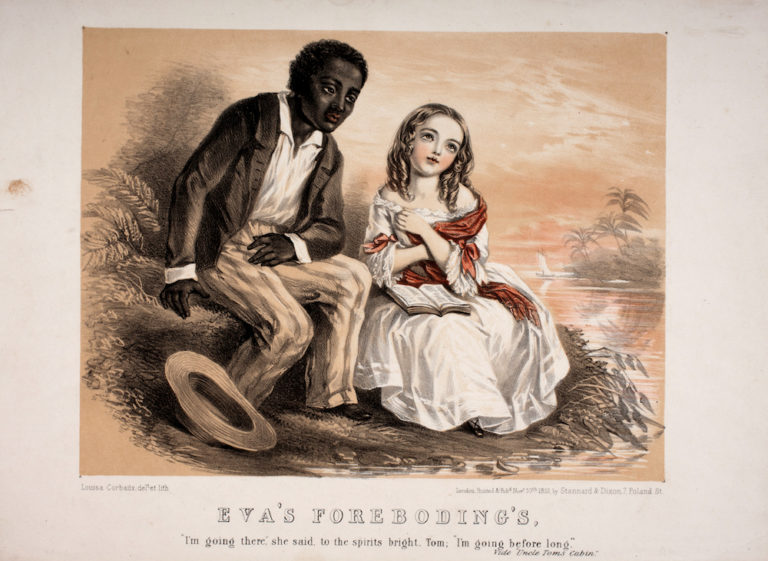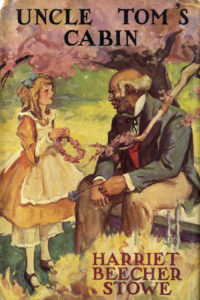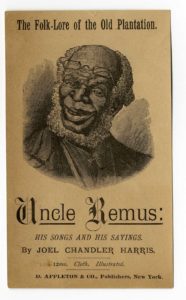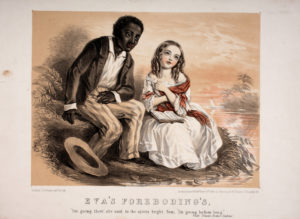A Tale of Two Uncles: The Old Age of Uncle Tom and Uncle Remus

Though Uncle Tom appears relatively young in Harriet Beecher Stowe’s famous novel, the perception of his age changed. The narrator of Uncle Tom’s Cabin (1852) invites the reader to observe “the hero of our story,” Uncle Tom, “a large, broad-chested, powerfully-made man, of a full glossy black” and his wife, Aunt Chloe, who shares his sheen with her “round, black, shining face,” which is “so glossy as to suggest the idea that she might have been washed over with white of eggs.” There are three children in their cabin: two young boys, Mose and Pete, running around at their feet, and a baby girl. If one puts aside the not insignificant matter of their enslavement, then the two look every bit the picture of domestic bliss—young, healthy parents, who don’t have a wrinkle between them.
Yet by the turn of the century Uncle Tom had become much older in illustrations for the novel and in American popular culture more broadly: his hair changed from black to grey and balding, his face wrinkled, and his body stooped. The Annotated Uncle Tom’s Cabin (2006) shows the far-reaching effects of this change when it hesitates to identify the three children in the cabin as belonging to Uncle Tom and Aunt Chloe since their relationship allegedly resembles that of Abraham and Sarah. In the biblical story, the prophecy that the couple will have a child makes Sarah laugh—she was ninety and Abraham was 100 years old when their child, Isaac, was born.
The perception of Uncle Tom’s age clearly defies Stowe’s original description and exchanges the strong, powerful middle-aged young father with an old man whom he barely resembles. Given the cultural importance of Stowe’s novel and its afterlife, this particular transformation bears further consideration. Why does Uncle Tom grow old? Why does Uncle Remus, who becomes popular at the turn of the century, look so similar to him? What does it mean that he does?
The stage performances of Uncle Tom’s Cabin, known as Tom plays, offer one explanation. Harriet Beecher Stowe’s novel was a literary phenomenon and when it took to the stage it became even more popular. Famously, Thomas F. Gossett has suggested that for every one person who read Stowe’s novel, there were fifty who attended one of the countless performances of the Tom plays, staged by as many as 500 companies and running from 1852 to 1930. Changes to characters, scenes, and plot inevitably occurred, including the use of live dogs to embellish the scene where Eliza flees across a frozen river.
The actors portraying Stowe’s characters often became more visually iconic than the characters in the book. Just as film adaptations change how we imagine characters of novels we’ve read so that Harry Potter becomes Daniel Radcliffe and Katniss Everdeen becomes Jennifer Lawrence, the stage personas of the Tom plays eclipsed their textual source. Robin Bernstein has shown, for example, how child actress Cordelia Howard’s brown hair became an iconic depiction of Little Eva, despite the fact that Stowe describes Eva as having golden blonde hair. Uncle Tom’s old age was yet another change made as the plays upstaged the novel. The plays were simply more accessible, more visceral, and more social than the written word, and without copyright restrictions to speak of they had the freedom to alter the content and characters of Uncle Tom’s Cabin in profoundly influential ways.
The Tom plays were an outgrowth of blackface minstrelsy and they borrowed its stereotypes. A nineteenth-century entertainment staple, minstrel shows featured white actors who blackened their faces to engage in racial caricature. The aged slave was one such stereotype and while Stephen Foster’s “Old Uncle Ned” may have been the most famous example, other variations included “Old Dan Tucker” and “Old Black Joe.” Uncle Tom’s age rose upward, pulled by the collective influence of these pre-existing characters, until he melded into just another older slave, no different than any other. Charles Townsend, for example, recorded the directions for blacking up “for elderly negroes, like ‘Uncle Tom,’” which included drawing wrinkles “across the forehead and around the eyes, with India ink” and accentuating the lower eyelids and lips, “which will give them the sunken look of old age.” The physical manifestation of old age lent itself to minstrelsy’s tendency to emphasize racial weakness and dependency, which resulted in the association of old age and loyalty. The Tom plays exaggerated Uncle Tom’s age due to the influence of the minstrel stage, using it to make him seem impotent, weak, and complacent. The effect was the stigmatization of the name “Uncle Tom” into the epithet that it has become.
The other explanation for Uncle Tom’s increasing age has to do with his proximity to Little Eva. The daughter of Augustine St. Clare, Eva is saved by Tom when she falls off a steamship carrying a cargo of slaves to New Orleans to be sold. She persuades her father to purchase him as compensation for his heroism. Once they return to the plantation together, Uncle Tom and Eva become fast friends as she reads the Bible to him. When Eva falls ill later in the story, they become quite close: Uncle Tom carries Eva into and out of her room when she is too weak; he takes walks with her, sings hymns to her, and sits with her. When she nears death, he sleeps outside of her room on the verandah. Eva seems innocent in these scenes and Uncle Tom seems trustworthy and loyal. As Robin Bernstein discusses in Racial Innocence, Eva’s purity, her childhood innocence, allows her to transcend racial prohibitions. The physical intimacy shared between Uncle Tom and Eva becomes permissible, or at least explicable, when cast under the glow of her pure, angelic aura.
However, to some who feared the intermingling of races, Eva seemed vulnerable and the proximity between her and Uncle Tom proved disconcerting. Eva’s purity might sanction her relationship to Uncle Tom, but it could just as easily be spoiled by it. Age, while not resolving the racial tension stemming from the proximity between a white girl and a black man, certainly provided a more tolerable picture for those who held such anxieties. The older Uncle Tom became, the more the tension was alleviated between the two. The influence of the minstrel stage on Uncle Tom’s age provided a complementary solution to the problem of physical intimacy by adding a layer of separation. Insofar as Uncle Tom becomes old, he becomes, to borrow James Baldwin’s phrase, “divested of his sex,” and more like a grandparent for Eva. And, once Uncle Tom is estranged from his own family because he is too old for the children in the cabin to be believably his, the decision to be loyal to Eva above all else becomes easy. As Uncle Tom ages, his proximity becomes more tolerable and less threatening.
Just as Uncle Tom became old on the stage, another aging ex-slave entered American popular culture: Joel Chandler Harris’s Uncle Remus. The two would prove indissoluble—it is almost as if Uncle Tom aged into Uncle Remus. Harris developed his signature formula in the Atlanta Constitution in which Uncle Remus tells stories set in the antebellum past to an audience—a nameless Little Boy—in the postbellum present. The stories are animal folktales that feature Brer Rabbit narrowly escaping the grasp of Brer Fox with his trickster antics. On the basis of these entertaining folktales in Uncle Remus: His Songs and His Sayings (1880), Harris rose from regional to national fame and became one of the most significant literary figures in the late nineteenth- and early twentieth-century United States. When Harris asks the reader of his first book to imagine Uncle Remus as one who looks as though he lived in the period he describes, that is, an old man who was an adult well before the Civil War, for many the image that came to mind was Uncle Tom. On their respective laps sat different children, but the image of an elderly black man with a white child stayed the same. The two blurred to the point that in Young Folks’ Uncle Tom’s Cabin (1901), it is Uncle Tom, not Uncle Remus, telling Eva Brer Rabbit stories.
At the 1905 Georgia State Fair in Atlanta, President and Mrs. Theodore Roosevelt drew out Joel Chandler Harris, who was notoriously reclusive. With Harris seated as a guest of honor at the presidential banquet, Roosevelt remarked, “Presidents may come and presidents may go; but Uncle Remus ‘stays put,’” before going on to praise him for the way he was able to exalt the South in his fiction without “even a flavor of bitterness toward any other part of the Union.” Roosevelt’s praise seems to be the exact opposite of the message Stowe apocryphally received from Lincoln: “so you’re the little woman who wrote the book that started this great war.” According to Roosevelt, Uncle Remus helped heal the tensions of the war started by Uncle Tom. This transformation from instigator to alleviator is indicative of how old age effaced the anti-slavery politics of Uncle Tom’s Cabin. Furthermore, I would submit that at least part of the reason why Uncle Remus seemed like he was always there is because Uncle Tom became old first.
What Roosevelt valued about Uncle Remus and, by extension, Uncle Tom, is troubling in retrospect. The saccharine stories without “even a flavor of bitterness” helped reconcile white Northerners and white Southerners at the expense of African Americans, whose suffering was denied by the manufactured consent imposed upon them. Imagining loyal, aged slaves who were nostalgic for the plantation economy helped the North find an exculpation for its long-time complicity in slavery, its failure to enact emancipation sooner, and its quitting of Reconstruction; it helped the South imagine a romanticized past that could justify disenfranchisement through Jim Crow legislation while preserving the illusion of Southern valor. Old age and loyalty became inextricable, and so too did Uncle Remus and Uncle Tom, their transformation made so complete it erased the traces of any transformation in the first place by making it seem as if they were never not there.
There are, however, two differences between Uncle Tom and Uncle Remus that I wish to bring to your attention in closing. Together they are indicative of a widespread shift in the cultural meaning of old age in the United States after the Civil War that often slips past unnoticed in the story of shared resemblance I’ve described above. The first difference is a mortal one: Uncle Tom dies while Uncle Remus stays old.
Uncle Remus was already old when he appeared in the first of Harris’s books in 1880, and in “A Story of the War,” he says he was old even before the war, let alone how he had aged since then. Yet in a volume published twenty-five years later, Told by Uncle Remus (1905), he is described as hale and hearty in spite of his age. The second difference between Tom and Remus is a didactic one, having to do with their relationships to the children with whom they are paired. Though children sit on their respective laps, Uncle Tom is taught while Uncle Remus teaches. Their respective lessons have to do with the past: Uncle Tom is taught about Christianity while Eva reads the Bible to him, and Uncle Remus teaches the Little Boy about the antebellum past through folk tales.
The two differences combine to make the meanings of their old age distinct. For Uncle Tom, old age is a penultimate state, meaningful only in its relation to death. The recognition of death’s value shows how receptive Uncle Tom has been as a vehicle for Eva’s religious instruction. By inviting death, Uncle Tom fulfills the role for which Eva has prepared him and accesses the religious meaning of martyrdom, his death conferring meaning upon his life. For Uncle Remus, however, old age becomes meaningful in and of itself. Unlike Uncle Tom, his value is contingent upon old age, not death. His lesson depends upon the continuation of his memory, so to die would be to lose value. Instead, Uncle Remus must stay put and in so doing he becomes doubly old: old enough to be a credible witness to the time of slavery and old enough to keep repeating his memory. Instead of a single generational transaction where Eva teaches Uncle Tom, Uncle Remus assumes a regenerative function, teaching generation after generation. When he reappears after a long absence, he returns in order to tell stories to another little boy, who is actually the child of the boy to whom he first told stories.
In this way, President Roosevelt incidentally puts his finger on the pulse of the matter. The “staying put” of old age assumes greater value at the turn into the twentieth century as the coming and going of death loses value. With the dissolution of the “good death” in the Civil War that Drew Gilpin Faust describes, what comes to take its place is old age. The threshold of death mediated power, culture, and identity in antebellum America. In the void left from its collapse, the cultural significance previously reserved for death began to creep into one’s late life.
The resemblance of Uncle Tom and Uncle Remus is important because it tracks the attenuated political meaning of Uncle Tom’s Cabin as Uncle Tom ages in appearance. Equally important, however, is an appreciation of their difference, which is suggestive of the widespread shift in the meaning of old age as a life stage. While it is common to think of the United States at this time as being reordered, reincorporated, reborn—in short, rejuvenated—by the process of economic modernization that accelerates after Reconstruction, perhaps old age plays a more fundamental role in that perception than previously thought.
Further Reading
Robin Bernstein, Racial Innocence: Performing American Childhood from Slavery to Civil Rights (New York, 2011).
Kathleen Diffley, “Representing the Civil War and Reconstruction: From Uncle Tom to Uncle Remus.” In Robert Paul Lamb and G. R. Thompson, eds. A Companion to American Fiction, 1865-1914 (Malden, Mass., 2005).
Thomas F. Gossett, Uncle Tom’s Cabin and American Culture (Dallas, 1985).
Barbara Hochman, Uncle Tom’s Cabin and the Reading Revolution: Race, Literacy, Childhood, and Fiction, 1851-1911 (Amherst, Mass., 2011).
Jo-Ann Morgan, Uncle Tom’s Cabin as Visual Culture (Columbia, Mo., 2007).
This article originally appeared in issue 17.2 (Winter, 2017).
Nathaniel A. Windon is a doctoral candidate at Penn State University. His dissertation, “Gilded Old Age,” is on the social construction of old age in the United States at the end of the nineteenth century.


